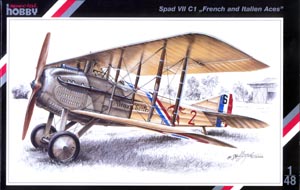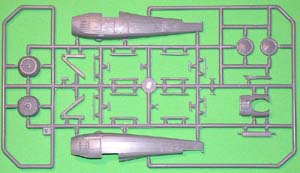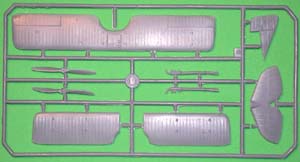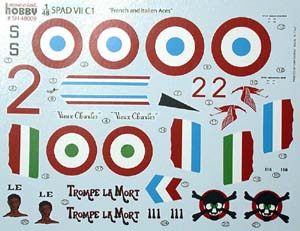Special Hobby 1/48 Spad VII.C.1
"French and Italian Aces" |  | History When wealthy French industrialist Armand Deperdussin began manufacturing airplanes shortly before WWI he named his company Societe' Provisoire des Aeroplanes Deperdussin. Although this was abbreviated "S.P.A.D." the airplanes were called "Deperdussins". The best known Deperdussins were a string of successful landplane and seaplane racers with monocoque fuselages of wood veneer. In 1914 Monsieur Deperdussin became involved in several big scandals that threatened the financial stability of France, and was arrested. He was let off - as big buck white collar criminals usually are - but he was tainted and, by extension, so was his airplane company. The directors of S.P.A.D. needed a credible new leader for the firm. They selected aviation pioneer and airplane manufacturer Louis Bleriot to head up the restructured S.P.A.D. and bought out Deperdussin's interests. Even though the airplanes were never previously called "Spads", the directors created a contorted new name designed to preserve the abbreviation S.P.A.D. - Societe' Anonyme pour l'Aviation et des Derives and their airplanes were now called "Spads". The first Spads, models A.2 through A.4 were unusual fighters, which carried a machine gunner and his weapon in a "pulpit" mounted in front (!) of the tractor mounted propeller. The first Spad that actually looked like the Spads that we know, was the S.V; the one-off prototype for their first conventional biplane fighter the S.VII, which is the subject of this review. I should mention that the convention in referring to Spads appears to wander all over the place from, for example, S.P.A.D. VII, to Spad VII, to Spad 7 and to S.7 and S.VII. Pick one that you like. Engineer Louis Bechereau, Spad's chief designer, chose the aero-engine derivative of an Hispano-Suiza ("Hisso") automobile engine designed by Swiss engineer Marc Birkigt to power the new S.V. This was the model 8Aa, 150 hp water cooled, vee-8. The S.V first flew in April 1916 and, following a brief development program, deliveries of the initial S.VII.C.1's began in August 1916. Early in 1917 the upgraded Hisso model 8Ab of 180 hp was introduced on the S.VII. By the time the S.XIII replaced the S.VII in production in the spring of 1917, a total of over 5,500 S.VII's had been built by S.P.A.D. and Bleriot in France, by Mann-Egerton in the UK and by DUKS in Russia. The S.VII's main shortcomings were that it had only one .303 caliber Vickers machine gun and was plagued with engine cooling problems and weak engine mounts. In spite of these problems it was well liked because it was fast and strong and could be dived with wild abandon with no fear of the wings either coming off or coming apart, which was a comfort to the pilot in the confused melee of a dogfight. Although it looks like a two-bay biplane the airplane is actually a single bay biplane. The intermediate "interplane struts" are actually only stay struts to damp vibration in the very closely spaced flying wires, which vibration would otherwise occur due to the aerodynamic disturbance the wires caused to one another. On many Spads the flying wires were also wrapped with tape to further reduce this vibratory tendency. In most other biplane designs double flying wires have two to four inches of separation. The Spad's landing wires were single and thus were not affected by this problem. The Kit  The well established Czech tradition of putting their kits in pre-crushed, flimsy, end-opening boxes is continued by this latest release from Special Hobby. This box has a very nice rendering of one of Georges Guynemer's (Ghee nuh may) famous Vieux Charles (Old Charles), s/n S115, on its front and back sides. Another, later, Vieux Charles Spad VII, s/n S.254, survives beautifully restored in the Musee' de l'Air at Le Bourget in Paris. The artist here, however, renders the fore part of the fuselage a pale grey rather than the light yellow metal lacquer actually used. This metal lacquer was just a bit darker than the light yellow dope used on most of the rest of the airplane - check your references. The well established Czech tradition of putting their kits in pre-crushed, flimsy, end-opening boxes is continued by this latest release from Special Hobby. This box has a very nice rendering of one of Georges Guynemer's (Ghee nuh may) famous Vieux Charles (Old Charles), s/n S115, on its front and back sides. Another, later, Vieux Charles Spad VII, s/n S.254, survives beautifully restored in the Musee' de l'Air at Le Bourget in Paris. The artist here, however, renders the fore part of the fuselage a pale grey rather than the light yellow metal lacquer actually used. This metal lacquer was just a bit darker than the light yellow dope used on most of the rest of the airplane - check your references. The kit comprises 37 parts cleanly injected molded in a medium grey styrene with no sink marks or warpage, 10 off-white resin detail parts, including the fuselage interior, 12 photo-etched brass detail parts, four vac formed clear windscreens - in two styles, one decal sheet and an eight page folder of well illustrated instructions. The instruction sheet does not adequately address rigging but the builder can figure out the rigging with reference to the box art.  Engineering of the kit is conventional with a one piece top wing and one piece, left and right, lower wing panels that butt-join to the fuselage roots at the production joint on the full size airplane. This butt-joint is the least satisfactory element of the kit's engineering. You really should use pieces of metal rod or tubing to reinforce these butt-joints. The kit designer has done nothing clever to assure proper alignment of the wings or landing gear. Guys - if you want to sell biplane kits in quantity to a larger market, you've got to make assembly and alignment easier for the average casual builder. Take a look at what DML/Dragon did with their Spad XIII - or better yet, take a look at what Monogram did with their series of 1:72 scale biplanes way back in 1968. Engineering of the kit is conventional with a one piece top wing and one piece, left and right, lower wing panels that butt-join to the fuselage roots at the production joint on the full size airplane. This butt-joint is the least satisfactory element of the kit's engineering. You really should use pieces of metal rod or tubing to reinforce these butt-joints. The kit designer has done nothing clever to assure proper alignment of the wings or landing gear. Guys - if you want to sell biplane kits in quantity to a larger market, you've got to make assembly and alignment easier for the average casual builder. Take a look at what DML/Dragon did with their Spad XIII - or better yet, take a look at what Monogram did with their series of 1:72 scale biplanes way back in 1968.  The instructions provide a brief history in Czech, English, German and French, a parts map, a 10 step assembly sequence and color/markings guides for three airplanes: Guynemer's already mentioned "Vieux Charles", Maxime Lenoir's (Lehn wahr) "Trompe La Morte" (Daredevil) and Fulco Ruffo di Calabria's plane in Italian markings with a skull and crossbones painted over the fuselage insignia roundel. The instructions provide a brief history in Czech, English, German and French, a parts map, a 10 step assembly sequence and color/markings guides for three airplanes: Guynemer's already mentioned "Vieux Charles", Maxime Lenoir's (Lehn wahr) "Trompe La Morte" (Daredevil) and Fulco Ruffo di Calabria's plane in Italian markings with a skull and crossbones painted over the fuselage insignia roundel. The kit is quite accurate, matching Ian Stair's drawings, noted in the references below, quite well. One significant detail is, however, omitted; the S.VII had two fuel lines and a coolant line that passed from the fuselage to the gravity feed fuel tank and to the radiator header tank in the center section of the top wing, which lines were usually enclosed in a streamlined fairing that looks rather like a large strut to the left of center next to the gun. This is the only missing detail that I noted. This fairing was often removed in the field - check your references for the particular subject that you are modeling. Conclusion The Special Hobby S.VII is on a par with the well known DML/Dragon S.XIII. Each has some features that are better than the other, but both will build into accurate representations of what they purport to be. The Special Hobby kit has no locating tabs for the fuselage halves or any other parts, but its decal sheet is better printed in more accurate colors than the sheet in the DML/Dragon kit and offers markings for three different airplanes whereas DML/Dragon offer markings for only one airplane. Kudos to Special Hobby for doing this kit. Please sirs - may we have some more WWI subjects in addition to your recently released Sopwith Tabloid and Lloyd C.V? This kit has also been released with markings other than those described here. I have not seen this other release. I bought the review kit from Emil Meinrich's Skyway Model Shop in Seattle for $27.00 plus sales tax. References -
-
Osprey Aircraft Of The Aces - 39 -SPAD VII aces of World War 1: Jon Guttman, Osprey Publishing, UK, 2001, ISBN: 1-84176-222-9. -
Osprey Aircraft Of The Aces - 42 - American Aces of World War 1: Norman Franks, Osprey Publishing, UK, 2001, ISBN: 1-85532-961-1. -
Osprey Aircraft Of The Aces -45- British and Empire Aces of World War 1: Christopher Shores, Osprey Publishing, UK, 2001, ISBN: 1-84176-377-2. -
Spad Fighters In Action, No. 93: John F. Connors, Squadron Signal Publications, Texas, 1989, ISBN: 0-89747-217-9. -
Scale Models Magazine - May 1980: Spads On The Western Front - Part 1, Neil Robinson, UK. -
Scale Models Magazine - June 1982: Excellent drawings of Spad VII by Ian R. Stair. If you're going to build a Spad VII, these drawings are your best single reference. -
Arco-Aircam Series - No. 9, Spad Scouts, S.VII - S.XIII: J. M. Bruce, Arco & Osprey Publishing, New York & London, 1969, ISBN: 668-02110-1. NB There is - alas - no DataFile on the S.VII (yet?) from Albatros Productions, Ltd. How about it Ray Rimell? [Editor's Note: The S.VII was Datafile No.8 - RNP] As usual, I will also ask if readers know of any other "Must Have" references on the Spad V.II? | 







|

 The well established Czech tradition of putting their kits in pre-crushed, flimsy, end-opening boxes is continued by this latest release from Special Hobby. This box has a very nice rendering of one of Georges Guynemer's (Ghee nuh may) famous Vieux Charles (Old Charles), s/n S115, on its front and back sides. Another, later, Vieux Charles Spad VII, s/n S.254, survives beautifully restored in the Musee' de l'Air at Le Bourget in Paris. The artist here, however, renders the fore part of the fuselage a pale grey rather than the light yellow metal lacquer actually used. This metal lacquer was just a bit darker than the light yellow dope used on most of the rest of the airplane - check your references.
The well established Czech tradition of putting their kits in pre-crushed, flimsy, end-opening boxes is continued by this latest release from Special Hobby. This box has a very nice rendering of one of Georges Guynemer's (Ghee nuh may) famous Vieux Charles (Old Charles), s/n S115, on its front and back sides. Another, later, Vieux Charles Spad VII, s/n S.254, survives beautifully restored in the Musee' de l'Air at Le Bourget in Paris. The artist here, however, renders the fore part of the fuselage a pale grey rather than the light yellow metal lacquer actually used. This metal lacquer was just a bit darker than the light yellow dope used on most of the rest of the airplane - check your references.  Engineering of the kit is conventional with a one piece top wing and one piece, left and right, lower wing panels that butt-join to the fuselage roots at the production joint on the full size airplane. This butt-joint is the least satisfactory element of the kit's engineering. You really should use pieces of metal rod or tubing to reinforce these butt-joints. The kit designer has done nothing clever to assure proper alignment of the wings or landing gear. Guys - if you want to sell biplane kits in quantity to a larger market, you've got to make assembly and alignment easier for the average casual builder. Take a look at what DML/Dragon did with their Spad XIII - or better yet, take a look at what Monogram did with their series of 1:72 scale biplanes way back in 1968.
Engineering of the kit is conventional with a one piece top wing and one piece, left and right, lower wing panels that butt-join to the fuselage roots at the production joint on the full size airplane. This butt-joint is the least satisfactory element of the kit's engineering. You really should use pieces of metal rod or tubing to reinforce these butt-joints. The kit designer has done nothing clever to assure proper alignment of the wings or landing gear. Guys - if you want to sell biplane kits in quantity to a larger market, you've got to make assembly and alignment easier for the average casual builder. Take a look at what DML/Dragon did with their Spad XIII - or better yet, take a look at what Monogram did with their series of 1:72 scale biplanes way back in 1968.  The instructions provide a brief history in Czech, English, German and French, a parts map, a 10 step assembly sequence and color/markings guides for three airplanes: Guynemer's already mentioned "Vieux Charles", Maxime Lenoir's (Lehn wahr) "Trompe La Morte" (Daredevil) and Fulco Ruffo di Calabria's plane in Italian markings with a skull and crossbones painted over the fuselage insignia roundel.
The instructions provide a brief history in Czech, English, German and French, a parts map, a 10 step assembly sequence and color/markings guides for three airplanes: Guynemer's already mentioned "Vieux Charles", Maxime Lenoir's (Lehn wahr) "Trompe La Morte" (Daredevil) and Fulco Ruffo di Calabria's plane in Italian markings with a skull and crossbones painted over the fuselage insignia roundel. 






